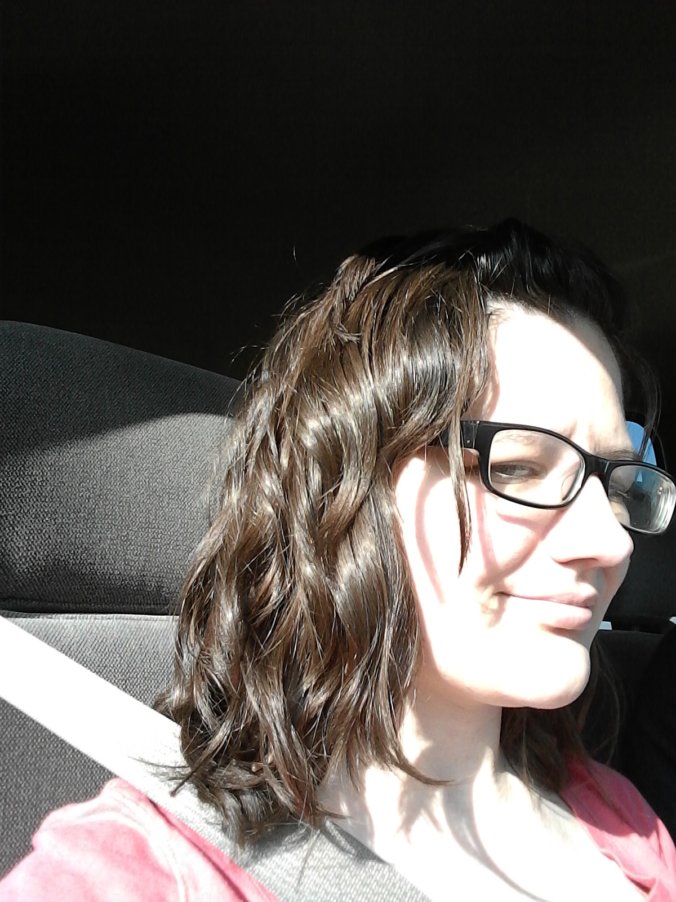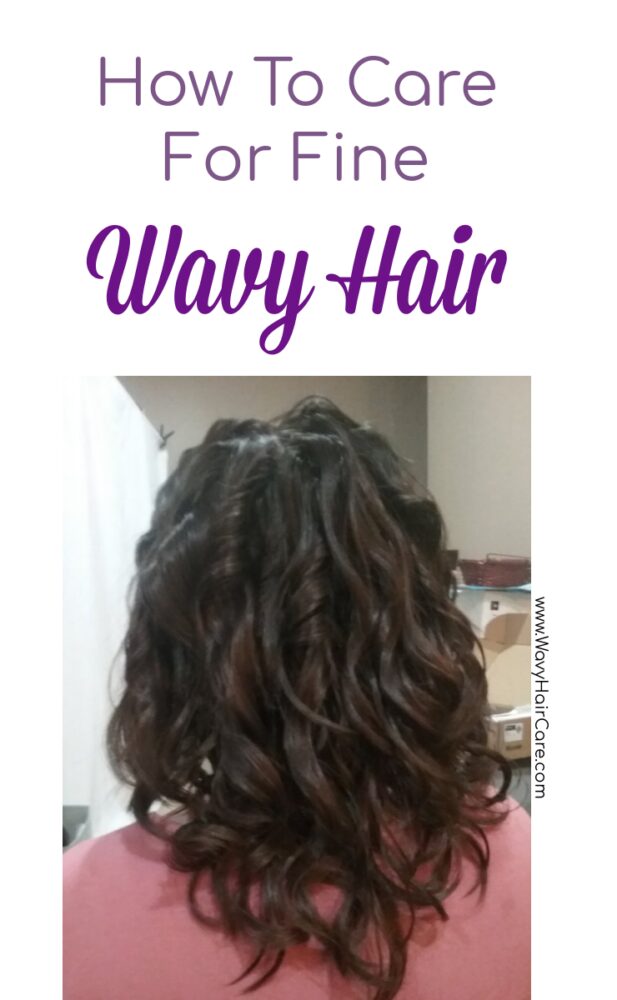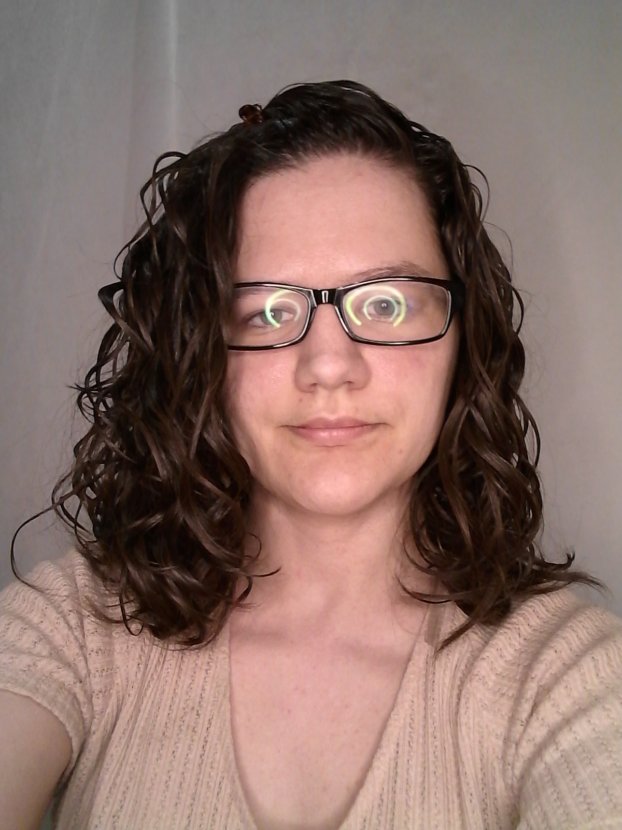A couple months ago I got a devacut on my wavy hair. It didn’t turn out like I had hoped…but I still benefitted from the experience. One of the best parts of the experience was that my stylist told me that I have fine hair.
I didn’t know this! I had previously believed that I had normal to thick hair strands, as that’s what results I got from a microscopic hair analysis test I did a couple of years ago.
While I would typically be inclined to believe the microscopic analysis over the stylist, when I thought about it, it made SO MUCH sense that my hair is fine rather than normal to thick. I had always thought that my hair didn’t behave the way that my hair type ‘should’. It makes way more sense that I just had my hair type wrong.
I often see others in wavy/curly communities recommend to newbies that they determine their hair type before they try to determine a hair routine that will work for them. I understand the logic behind this, but I also have found that it can be tricky to determine your hair type, which is why I don’t often give that advice myself.
However, I have now come up with a set of tests that I find to give the most accurate hair type results. So check out my post how to test your wavy hair type if you want to use my method for determining your hair type including porosity, density and thickness.
So first, I’ll share how to tell if you have fine hair and then I’ll go into what techniques or practices may work best for you if you have fine wavy hair.

How To Determine If Your Hair Is Fine
Take a single hair and place it between your thumb and index finger. When you look away from your hands, ask yourself if you can feel that hair. If you can’t really feel the hair, then your hair is fine!
I had heard about this test early on, and had initially thought my hair was fine. However, microscopic hair analysis told me that my hairs ranged from average to thick thickness, so I believed that for a long time. I now believe the hair analysis was incorrect, and the “finger test” and my hairstylist were correct.
How To Care For Fine Wavy Hair

1. Less Is More With Conditioning Products
Fine wavy hair is likely to be easily weighed down by conditioning products. Fine wavy hair is often smoother than thicker hair, too – so it may not need as much help from conditioners to be soft and manageable. Most likely you can get away with using a “light” (low or no oils/butters) conditioner, and a relatively small amount of it.
Many in the wavy hair community talk about using so much conditioner that your hair will feel like seaweed. If your hair is fine, you likely don’t need to use anywhere near that much. I use about a quarter-sized amount in my hair that is fine but dense, and a little bit past my shoulders in length.
Fine hair may not need a leave-in conditioner or cream, and may be easily weighed down from those products. If your hair does need them, I’d recommend using a very small amount and emulsifying it really well.
2. Less Is More With Water – To An Extent
Most of the time if you come across a curly girl method routine video, they’ll recommend adding gel to soaking wet hair. I thought that was the only way to apply gel when I was new to the curly girl method myself, because it’s what all the routines I came across said to do.
I didn’t know that this was just one type of styling and it’s called “wet styling.” You can also damp style! It just isn’t talked about as much in curly hair groups because most people with curly hair get their best results by wet styling.
For my fine wavy hair, damp styling works much better. If I apply gel to soaking wet hair, my results will be elongated or stretched out, and my roots will be pretty flat, as a result of the water weighing my hair down.
When you add gel, that’s basically the time that your hair starts trying to preserve the shape. So if I apply gel to my wet hair, it’s kinda stretched out. Where if I plop my hair first, it starts to spring up a little bit more, as it’s not as heavy from all that water anymore. Then I apply gel at that damp stage, and the shape preserved is tighter, more voluminous and more bouncy.
Check out my post on damp styling vs wet styling wavy hair to see the difference it makes on me.
However, if I wait too long and apply gel when my hair has gotten a little too dry, that can give me really stringy results as it keeps my curls from clumping well. It requires balance, and it took trial and error with plopping my hair for different lengths of time to determine what worked best for me. For me, it’s about 10-15 minutes of plopping and then adding products.
Confused about what the heck plopping is? See this blog post of mine – How to plop wavy hair.
PS – If your hair is easily weighed down by water, you may find that you get better results by diffusing rather than air drying. See my post air drying vs diffusing wavy hair to see the difference it makes on my hair.
3. More Is More With Styling Products With Hold.
Fine hair is more likely to be delicate or kind of weak, which means it needs strength or support from stylig products to maintain its style. My hair does best with strong-hold products.
Unfortunately, I find that some products market themselves as having a strong hold but perform more like a soft/medium hold. I’ve also found some products that advertise themselves as having a soft hold that perform like a hard hold. That’s frustrating! You can check out my mousse comparison post and my gel comparison post to see which hair products I find to truly have hard hold.
4. Your hair may like a lot of protein even if its low porosity
Frequently when reading about moisture vs protein and/or about porosity, you’ll see people state that low porosity hair doesn’t need much protein, while high porosity hair needs a lot of protein.
I’ve known for quite a while that my hair is fairly low porosity, yet it loves protein! I was confused about this until I learned that my hair is fine. It’s not discussed often, but fine hair tends to like protein more than coarse hair, because fine hair is weaker and needs the support!
The main place that I learned that fine hair needs more protein was on the science-y hair blog post Protein 101. That blog is an awesome resource for learning about hair, by the way!
5. Fine hair may do better with mousse than gel.
Some gels can be too heavy for fine hair. Mousse is really light, so many people with fine hair find that they prefer the results they get from mousse rather than gel. I have a whole blog post about the pros and cons of gel vs mousse.

What’s the difference between fine hair and thin hair?
People commonly confuse thin hair and fine hair. Fine hair is referencing individual hair strands, while thin hair references how much hair you have on your head (as in how dense your hair is).
In my case, my individual hairs are fine but dense, meaning I have a LOT of hairs, so my hair looks thick despite my individual strands being fine.
Other people sometimes have thick individual strands, but not have a lot of individual hairs, but their hair may still look fairly thick because their strands are large…but when their hair is wet, you can see a good bit of their scalp because they don’t have that many individual hairs…their hair is not very dense.
If your hair looks really thin, it’s likely fine AND thin, aka fine and low density.

Fine hair that is also thin may have unique needs.
If your hair is fine and low density, it may have different needs from hair that is fine and dense or fine and average density. Hair that is fine and low density may do better being styled with just a texturizing spray. I’ve seen a lot of people with fine and low-density wavy hair say that gel is too heavy for them, but mousse makes their hair stringy.
I have found that some gels are noticeably heavier than others, and that is even true for some mousses. I’ve also found that some products help my clumps, while others make my clumps thinner. So, I would recommend trying at least a few gels and a few mousses before writing off the entire product category.
Fine hair may be different from baby-fine
Most often, I just hear people discuss whether hair is fine or not. I personally think that there could be some benefit to differentiating between fine hair and VERY fine hair.
People often refer to really fine hair as ‘baby fine’ hair. In some ways, it seems that baby-fine hair may act more like fine and low density hair in that it may be too fragile to respond well to mousse, and may do best with just a texturizing spray.
If you have fine hair, especially if it is ‘baby fine’ or fine and low-density, please share what does and doesn’t work for your hair in the comments. I’m sure it will help others with the same hair type!
I’m pretty sure I also have fine wavy hair with just normal or slightly thin distribution across my head. But even though your hair is dense and mine is a bit more sparse, a lot of products and techniques you suggested have worked really well for me, so I wanted to thank you!
I also wanted to ask – have you ever tried the steam refresh method? I remember you saying you don’t typically need to refresh. But on days where you need definition to come back, it’s been really effective for me.
The only issue is it does create a bit of frizz, but the definition and volume I get when I do that still makes it worth it. 🙂
That’s awesome to hear that a lot of the same techniques seem to work for your lower desity hair, too!
I haven’t tried stream refreshing though I have been curious about it for a while! It’s encouraging to hear that it works well for you. Even though I don’t often bother with refreshing, I still want to explore it more so that I will know how to best refresh on days when I do really need to. Right now, anytime that I have anything important to attend where I need to be confident my hair will look good, I just wash my hair that day or the night before. It would be nice to be able to confidently refresh. So anyway I plan to experiment with a variety of ways of refreshing and take before/after photos so that I can compare different refresh methods and do a blog post on it. Steaming is definitely on of the ways I want to test out so I have to buy a steamer first but that post is on my ‘to do someday list, haha. 🙂
In my limited experience with refreshing so far, I find that refreshing always seems to introduce a little bit more frizz? I tend to see frizz on day 2+ as just being natural, really. But it doesn’t bother me too much. If I can get good waves, definition and volume I can handle some frizz. 🙂
Yeah, I bet it takes a decent amount of time to do the posts that you do. Me and a lot of other people really appreciate how you document experimenting different methods, though! 🙂
I bought the OGHom steamer on Amazon and as long as you use distilled water and don’t over-fill it, it’s a reliable little steamer. I just set it on my bathroom counter and lean the section of hair I’m refreshing into the steam and cup my hand under that section and lift the section up to encourage waves.
I definitely agree about the frizz, and I saw another person use a tiny bit of mousse with water and rub it on their hands and gently glaze that on their hair to tame frizz before diffusing for a few minutes to redefine the waves.
I’m wondering if I do that before steaming if it might prevent frizz once it’s diffused dry? It’s fun to try new things, so we’ll see! 🙂
My hair is also fine and very dense. It takes forever to dry, and it dries at the ends far quicker than near the scalp. I get a microfiber towel and blot my scalp to try to even it out. Then I add Uncle Funky’s in an attempt to get some clumping. Then I plop for twenty minutes or so. Then I add gel.
I either air dry or diffuse a bit, but not to all the way dry – that feels like too much heat, even on warm.
I agree with not too much conditioner and lots of holding product.
This post was AWESOME! I’m just now starting to research the “curly girl method”. I’m almost 50, work full time and have a 10 year old and with COVID and stress and going gray, I wanted to start being nicer to my hair and simplify. Having to blow it dry then style it every day, do make up, get my daughter ready, yada, yada, yada, was a racket. So, the curly method seemed a way to simplify things. All my initial research seemed to suggest adding product to my sopping wet hair. Not only did it feel really icky to do (LOL), but it did not work – at all. I grew up in the 80s, so this was not the way I used to use gel. I, like you, also have fine hair and tons of it. It tangles and does tend to fizz, but holds on to all that water and the products just seem to disappear. So, all that time I used trying to simplify and do right by my hair was simply a waste. Thank you for this post. Now I know why it was not working. I intend to tweak it some and see what happens next time. Such awesome information here! I will now delve more into the blog to see what else might help with my hair since we seem to be the same. 🙂
That’s awesome! I hope some of what has worked better for me will also work better for you. Would love to hear how it goes! Good luck.
Very helpful information. Great article. Everything that you wrote is spot on for my hair.
My hair is relatively fine BUT dense. many stylists over the years told me that my hair was thick so I would use products for thick hair and then my hair felt weighed down. I never could figure out what I was doing wrong until the CMG movement helped me figure out what my hair needed.
Hi there!
I have recently discovered (only a few days) that I have wavy (possibly curly when it gets healthier.
I followed your method of testing (washing, scrunching, mousse, plopping, scrunch the crunch) but I find my hair (even once dried) almost looks stringy, almost passing off as still wet. My hair is quite dense, I think it is fine-medium thickness, and as it has bleached ends I believe it is porous but have not had a chance to double check.
I am just curious as to what I can adjust to fix this issue? Im so excited to embrace my wavy (hopefully future curly) hair
I was also wondering how you go about detangling hair? I have hear a mix or water and leave in conditioner misted and then combed or wet brushed – would you scrunch, plop and mousse after this?
Hi! It’s always fun to hear from people who are brand new, it reminds me of how exciting it all was when I first got started :).
My guess for the stringy-ends and wet look is that you could try either use less of your mousse, or a mousse that has lighter hold, as it sounds like you’re struggling to get your hair to be soft enough after you scrunch out the cast.
My hair doesn’t tangle hardly at all so I don’t have personal experience with it, but the method you referenced of spraying in water and leave in conditioner and then detangling it, plopping and adding in more mousse is definitely a reasonable thing to try. Lots of wavies/curlies do that or something very similar. You may even find that you can do that except skip adding in more mousse. Often just getting your hair wet again will “reactivate” mousses and gels so you may find that if you just scrunch your hair after getting it damp and detangling it, that it’ll get a cast again without needing more product.
I guarantee if you have used any chemicals or heat tools on your hair, then it is permanently damaged until it grows out and is cut off. That means that your cuticle is either open or fallen off.That happened to me. Fine hair is much more vulnerable to damage than courser hair. Your new hair growth can be a totally different type than what is at the ends. I quit coloring my hair and I never use heat tools, only a dryer on low or medium which I move around a lot. I don’t dry it to completion. It takes time to heal your hair.
This is a huge help. Was wondering if you had any advice for the next morning as someone who is just . I read your articles about refreshing wavy hair on day 2. But I find my hair is just impossible in the morning and most of the time I don’t have time to do anything but brush it (especially cause I have to wear my hair up neatly for work). Is there anything you can recommend to do? I wake up and it’s like a nest and any waves that I managed to keep have disintegrated.
Glad you found it helpful! I did an experiment a while back where I tried 8 different methods for freshing my hair on day 2 to see what worked best. You can check out the post below for more detail, but I found that the best way to regain definition was to completely re-wet my hair (though that’s VERY time consuming!), the best way to get rid of frizz was to refresh by adding in more gel or mousse. This still takes some time as I have to diffuse my hair to get it to dry after applying.
https://wavyhaircarer.com/the-best-way-to-refresh-wavy-hair-8-methods-compared-with-pictures/
If you don’t want to refresh, adjusting how you sleep on your hair may help some. I did a post comparing methods of sleeping on wavy hair to see which left my hair in the best shape. I’ll link it below if you want to check out the details, but I found that sleeping in a silk-lined cap (not quite the same thing as a bonnet) worked best for me.
https://wavyhaircarer.com/i-tested-what-is-the-best-way-to-sleep-on-wavy-hair/
I’ve also found that if I use really hard hold products on wash day, that my hair will stay wavier when I sleep vs if I only get light hold on wash day and then sleep on it, it’ll fall apart way more overnight.